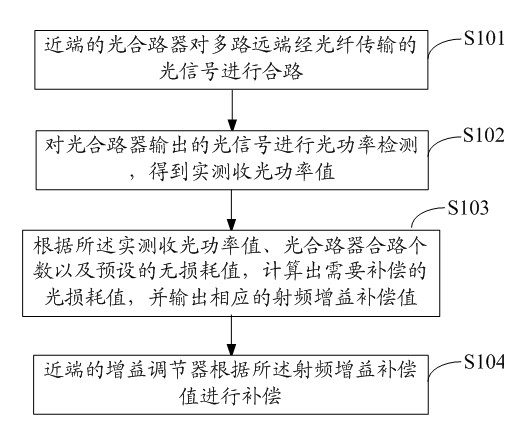Method for automatically compensating ascending optical loss gain and near end of optical fiber repeater
A technology of optical fiber repeater and gain compensation, which is applied in the field of mobile communication, can solve problems such as complex algorithms, low reliability, and complex software design, and achieve the effects of simple and effective algorithms, high reliability, and simple software design and debugging
- Summary
- Abstract
- Description
- Claims
- Application Information
AI Technical Summary
Problems solved by technology
Method used
Image
Examples
Embodiment Construction
[0032] In order to make the object, technical solution and advantages of the present invention clearer, the present invention will be further described in detail below in conjunction with the accompanying drawings and embodiments. It should be understood that the specific embodiments described here are only used to explain the present invention, not to limit the present invention.
[0033] figure 1 The uplink of the optical fiber repeater provided by the embodiment of the present invention is shown, and other components irrelevant to the present invention are omitted for the convenience of explaining the problem.
[0034] The number of remote ends carried by the near end of the optical fiber repeater is determined by the actual project. The embodiment of the present invention is a typical 1 to 4. After the uplink input of the 4 remote ends is adjusted by gain, the radio frequency signal is converted into an optical signal. Optical fiber transmission to the proximal end. The ...
PUM
 Login to View More
Login to View More Abstract
Description
Claims
Application Information
 Login to View More
Login to View More - R&D
- Intellectual Property
- Life Sciences
- Materials
- Tech Scout
- Unparalleled Data Quality
- Higher Quality Content
- 60% Fewer Hallucinations
Browse by: Latest US Patents, China's latest patents, Technical Efficacy Thesaurus, Application Domain, Technology Topic, Popular Technical Reports.
© 2025 PatSnap. All rights reserved.Legal|Privacy policy|Modern Slavery Act Transparency Statement|Sitemap|About US| Contact US: help@patsnap.com



